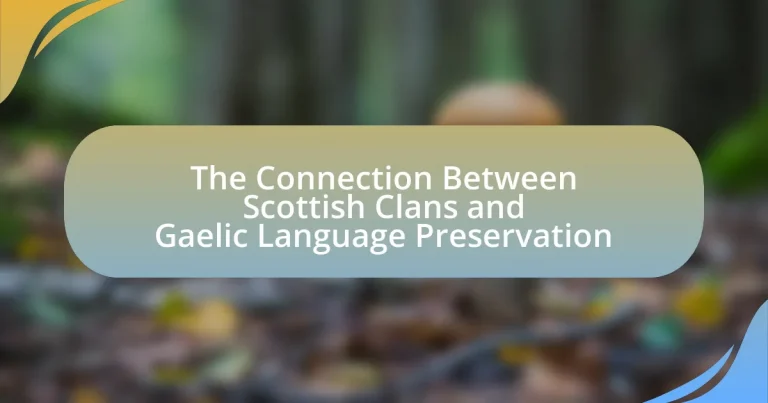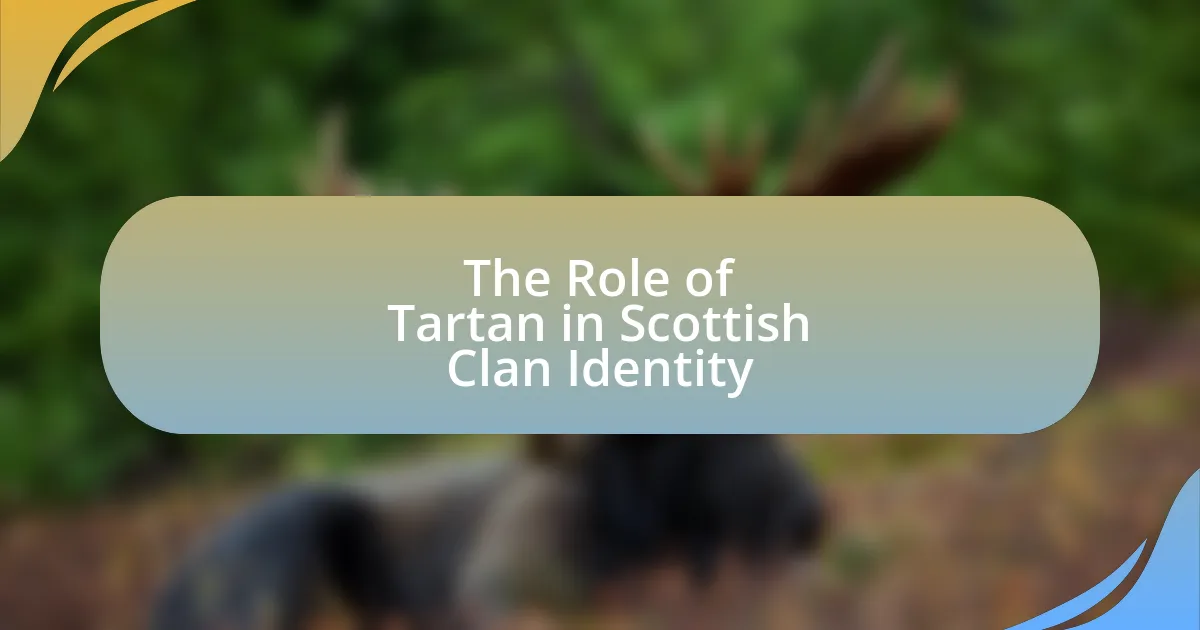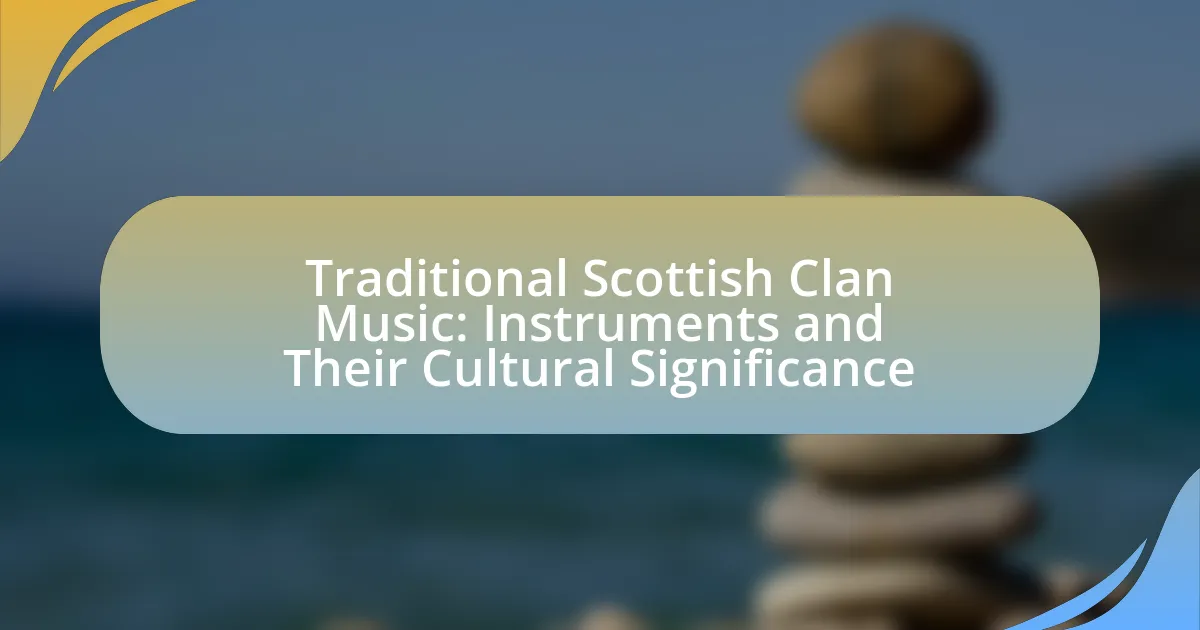The article examines the significant connection between Scottish clans and the preservation of the Gaelic language, highlighting how clans serve as cultural custodians of Gaelic traditions through storytelling, music, and oral history. It discusses the historical influence of clans on the use of Gaelic, particularly in the Highlands, and the role of clan leaders in promoting the language as a symbol of identity. The article also addresses the challenges faced by Gaelic language preservation today, including declining speaker numbers and the impact of globalization, while outlining effective strategies and initiatives that clans can adopt to revitalize and support Gaelic language learning within their communities.
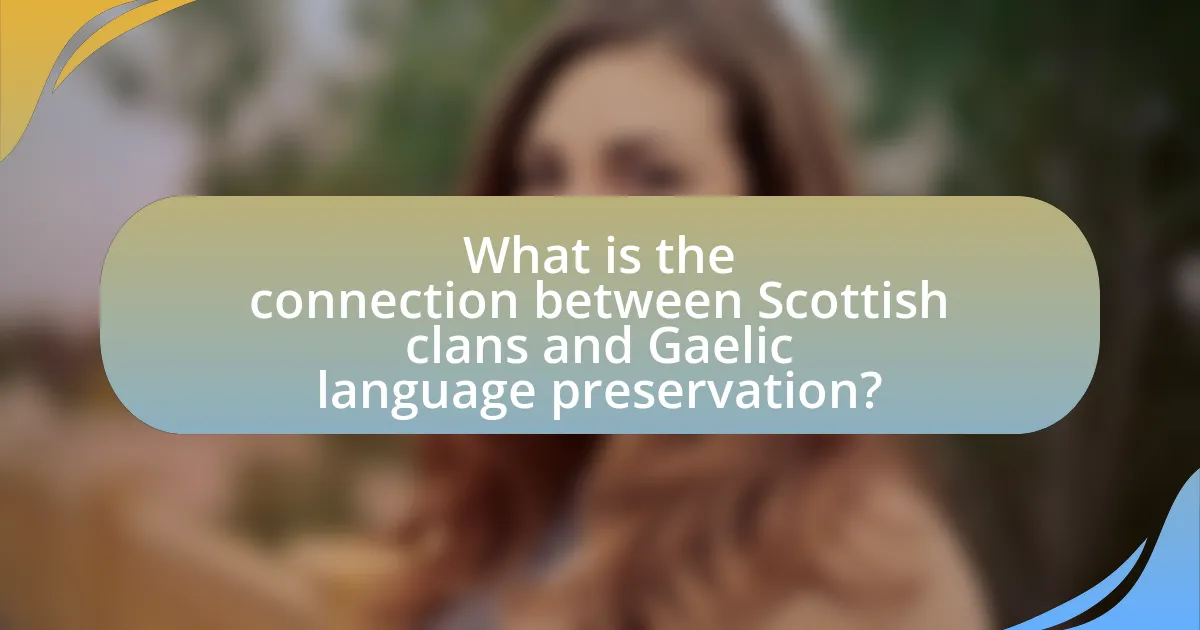
What is the connection between Scottish clans and Gaelic language preservation?
Scottish clans play a significant role in the preservation of the Gaelic language, as they are integral to the cultural identity and heritage of Gaelic-speaking communities. Clans often serve as custodians of traditional Gaelic customs, including language, through storytelling, music, and oral history, which are passed down through generations. Historical evidence shows that many clan leaders actively promoted the use of Gaelic in their territories, fostering an environment where the language could thrive. For instance, the Clan MacDonald and Clan Campbell have been noted for their contributions to Gaelic literature and education, reinforcing the language’s importance in clan gatherings and ceremonies. This connection highlights how the social structures of clans have directly influenced the survival and revitalization of the Gaelic language in Scotland.
How did Scottish clans influence the use of the Gaelic language?
Scottish clans significantly influenced the use of the Gaelic language by serving as cultural and social hubs that promoted its use in daily life and traditions. Clans often held gatherings, known as ceilidhs, where Gaelic was spoken, songs were sung, and stories were shared, thereby reinforcing the language within their communities. Additionally, clan leaders, or chiefs, were instrumental in maintaining Gaelic as a symbol of identity and heritage, which encouraged clan members to adopt and preserve the language. Historical records indicate that during the 18th and 19th centuries, the Gaelic language thrived in clan territories, particularly in the Highlands, where it was the primary means of communication among clan members. This cultural emphasis on Gaelic within clans contributed to its survival despite external pressures, such as the Anglicization of Scotland.
What historical factors contributed to the Gaelic language’s prominence among clans?
The prominence of the Gaelic language among clans was primarily influenced by the socio-political structure of Scottish society, where clans operated as tight-knit communities with their own leaders and customs. The Gaelic language served as a vital means of communication and cultural identity, fostering unity and loyalty among clan members. Historical events, such as the establishment of the Gaelic-speaking Kingdom of Dal Riata in the 6th century and the subsequent spread of Gaelic through clan territories, reinforced its use. Additionally, the patronage of Gaelic by clan chiefs, who often commissioned poetry and storytelling in the language, further solidified its status. The language’s prominence was also supported by the oral tradition, which preserved clan histories and legends, ensuring that Gaelic remained central to clan identity and cohesion.
How did clan culture support the transmission of the Gaelic language?
Clan culture supported the transmission of the Gaelic language by fostering a strong sense of identity and community among its members, which prioritized the use of Gaelic in daily life and cultural practices. Clans often held gatherings, storytelling sessions, and ceremonies where Gaelic was the primary language spoken, thus reinforcing its use among generations. Additionally, clan leaders and elders played a crucial role in teaching the language to younger members, ensuring that Gaelic was passed down as a vital part of their heritage. Historical records indicate that during the 18th and 19th centuries, clan gatherings were instrumental in maintaining Gaelic traditions, as evidenced by the prevalence of Gaelic in oral histories and songs shared within these communities.
Why is the Gaelic language important to Scottish clan identity?
The Gaelic language is crucial to Scottish clan identity because it serves as a key cultural marker that connects clans to their historical roots and traditions. Gaelic embodies the unique heritage, stories, and values of each clan, reinforcing a sense of belonging and continuity among members. For instance, many clan names and mottos are derived from Gaelic, reflecting the language’s integral role in clan history and identity. Additionally, the revival and preservation of Gaelic language initiatives, such as education programs and media, highlight its significance in maintaining clan connections and fostering pride in Scottish heritage.
What role does language play in the cultural heritage of Scottish clans?
Language serves as a vital component of the cultural heritage of Scottish clans by preserving traditions, identity, and historical narratives. The Gaelic language, in particular, embodies the unique customs and values of these clans, facilitating the transmission of folklore, songs, and clan histories across generations. For instance, many clan names and their associated stories are rooted in Gaelic, reflecting the clan’s lineage and territorial ties. Furthermore, the revival efforts of the Gaelic language in Scotland underscore its significance in maintaining cultural identity, as seen in educational programs and community initiatives aimed at promoting Gaelic literacy and usage. This connection between language and cultural heritage is evidenced by the fact that over 57,000 people in Scotland reported speaking Gaelic in the 2021 census, highlighting its ongoing relevance in clan identity and cultural expression.
How does the Gaelic language reflect the values and traditions of clans?
The Gaelic language reflects the values and traditions of clans by serving as a vessel for cultural identity, historical narratives, and social cohesion. Gaelic contains specific vocabulary and phrases that embody clan heritage, such as terms for kinship, land, and traditional practices, which reinforce the importance of familial ties and community. For instance, clan mottos and songs often utilize Gaelic, preserving the stories and values that define each clan’s unique identity. Additionally, the language’s revival efforts, particularly in educational settings, highlight the clans’ commitment to maintaining their cultural legacy, as seen in initiatives like the Gaelic Medium Education program in Scotland, which aims to teach children in Gaelic, thereby ensuring the transmission of clan values to future generations.
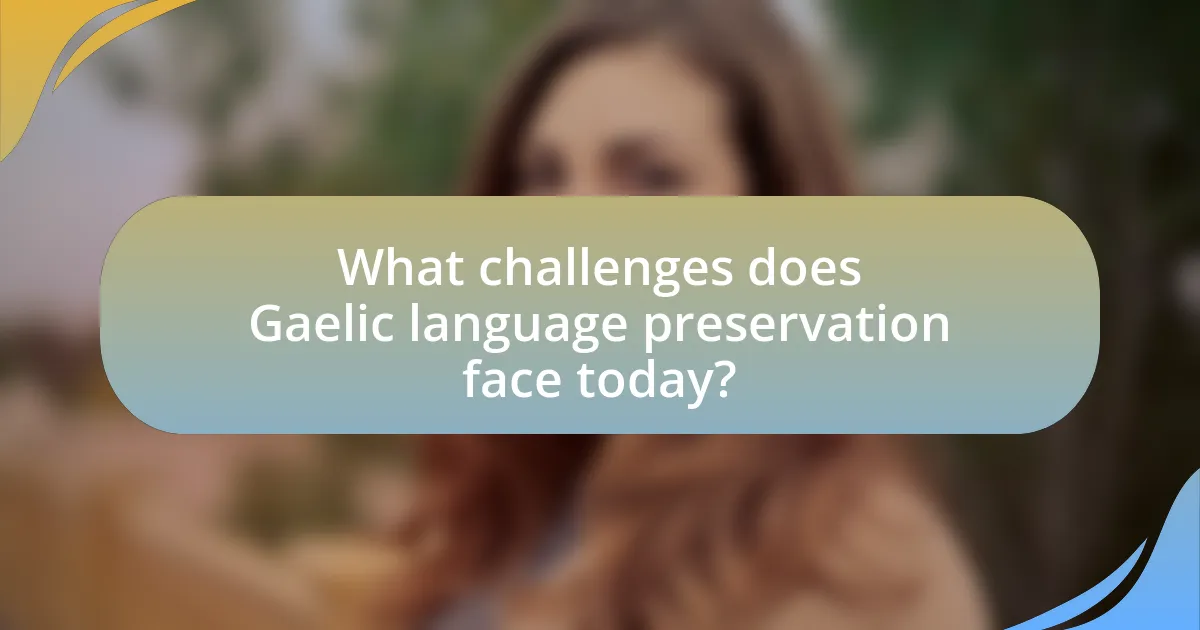
What challenges does Gaelic language preservation face today?
Gaelic language preservation faces significant challenges today, primarily due to declining speaker numbers and limited institutional support. The number of Gaelic speakers in Scotland has decreased from around 250,000 in the 2001 census to approximately 57,000 in the 2021 census, highlighting a critical loss of linguistic heritage. Additionally, the lack of resources in education and media contributes to the language’s vulnerability, as many schools do not offer Gaelic as a subject, and media representation remains minimal. Furthermore, societal attitudes towards the language often favor English, leading to a diminished status for Gaelic in everyday life. These factors collectively threaten the survival and revitalization of the Gaelic language.
How have modern influences affected the Gaelic language within clans?
Modern influences have significantly impacted the Gaelic language within clans by accelerating its decline and altering its usage patterns. The rise of globalization and the dominance of English in media, education, and daily communication have led to a decrease in Gaelic speakers, particularly among younger generations. According to the 2011 Census, only 1.1% of Scotland’s population reported being able to speak Gaelic, highlighting the language’s vulnerability. Additionally, the integration of technology and social media has shifted communication preferences, often favoring English, which further marginalizes Gaelic. These factors collectively contribute to the erosion of Gaelic language use within clans, threatening cultural heritage and identity.
What impact does globalization have on Gaelic language usage?
Globalization negatively impacts Gaelic language usage by promoting dominant languages, leading to a decline in the number of speakers. As global communication increasingly favors English and other widely spoken languages, the visibility and utility of Gaelic diminish, resulting in fewer opportunities for its use in everyday contexts. According to the 2011 Census in Scotland, only 1.1% of the population reported being able to speak Gaelic, highlighting the language’s vulnerability in a globalized world where cultural homogenization often sidelines minority languages.
How do educational systems support or hinder Gaelic language learning?
Educational systems can both support and hinder Gaelic language learning through curriculum design, resource allocation, and teacher training. Support is evident in initiatives like Gaelic-medium education, which immerses students in the language from an early age, fostering fluency and cultural connection. For instance, the Scottish Government’s commitment to increasing Gaelic education has led to a rise in Gaelic-medium schools, with enrollment increasing by 20% from 2011 to 2021. Conversely, hindrance occurs when educational policies prioritize English over Gaelic, resulting in limited resources and insufficient teacher training for Gaelic instruction. A report by Bòrd na Gàidhlig highlights that many schools lack qualified Gaelic teachers, which directly impacts the quality of language education. Thus, the effectiveness of educational systems in promoting Gaelic language learning is contingent upon their commitment to resource investment and curriculum inclusivity.
What initiatives are in place to promote Gaelic language preservation among clans?
Various initiatives are in place to promote Gaelic language preservation among clans, including educational programs, community events, and digital resources. Organizations such as Bòrd na Gàidhlig and the Gaelic Language Act support these initiatives by funding language courses and cultural activities that encourage the use of Gaelic within clan communities. Additionally, clans often host gatherings and festivals that feature Gaelic language workshops, storytelling, and music, fostering an environment where the language can thrive. These efforts are crucial in maintaining the cultural heritage associated with the Gaelic language, as evidenced by the increase in Gaelic speakers in Scotland, which rose to over 57,000 according to the 2011 census.
What role do Scottish clans play in revitalizing the Gaelic language?
Scottish clans play a significant role in revitalizing the Gaelic language by fostering cultural identity and community engagement. Clans often organize events, such as ceilidhs and festivals, where Gaelic is spoken and celebrated, thus encouraging its use among younger generations. Additionally, many clans support educational initiatives that promote Gaelic language learning, such as scholarships and language courses. For instance, the Clan MacLeod has been involved in Gaelic language projects, demonstrating a commitment to preserving their heritage. This active participation not only helps maintain the language but also strengthens the cultural ties within the clan and the broader Scottish community.
How can community engagement enhance Gaelic language preservation efforts?
Community engagement can significantly enhance Gaelic language preservation efforts by fostering a sense of ownership and belonging among speakers and learners. When communities actively participate in language initiatives, such as local classes, cultural events, and storytelling sessions, they create an environment that values and promotes the use of Gaelic in everyday life. Research indicates that community-led programs, like the Gaelic Language Plan implemented in Scotland, have led to increased language use in homes and public spaces, demonstrating the effectiveness of grassroots involvement. Furthermore, studies show that when individuals feel connected to their cultural heritage through community engagement, they are more likely to pass the language on to future generations, thereby ensuring its survival and growth.

What are effective strategies for supporting Gaelic language preservation within clans?
Effective strategies for supporting Gaelic language preservation within clans include implementing language immersion programs, promoting intergenerational language transmission, and utilizing digital resources for learning. Language immersion programs, such as Gaelic-medium education, have been shown to significantly increase fluency among younger generations, as evidenced by the success of schools in Scotland where students are taught primarily in Gaelic. Promoting intergenerational transmission encourages elders to teach the language to younger clan members, fostering a natural learning environment that strengthens familial bonds and cultural identity. Additionally, utilizing digital resources, such as online courses and mobile applications, provides accessible learning tools that can engage clan members of all ages, thereby enhancing language acquisition and usage within the community.
How can clans foster a stronger connection to the Gaelic language?
Clans can foster a stronger connection to the Gaelic language by actively promoting its use in their community activities and events. For instance, clans can organize Gaelic language classes, cultural workshops, and storytelling sessions that encourage members to engage with the language. Additionally, clans can incorporate Gaelic into their official communications, such as newsletters and social media, to normalize its usage. Research indicates that community engagement in language learning significantly enhances retention and fluency, as seen in the success of initiatives like the Gaelic Language Plan in Scotland, which has led to increased Gaelic speakers in areas with active community involvement.
What resources are available for clans to promote Gaelic language learning?
Clans can utilize various resources to promote Gaelic language learning, including online courses, community classes, and educational materials. Organizations such as Bòrd na Gàidhlig provide funding and support for Gaelic language initiatives, while platforms like Duolingo and LearnGaelic.com offer accessible online learning tools. Additionally, local community centers often host Gaelic language classes and cultural events that encourage participation and practice. These resources are essential for fostering a supportive environment for Gaelic language acquisition and preservation within clans.
How can intergenerational transmission of the Gaelic language be encouraged?
Intergenerational transmission of the Gaelic language can be encouraged through community-based language programs and family engagement initiatives. These programs can include immersive language classes for children and parents, storytelling sessions in Gaelic, and cultural events that celebrate Gaelic heritage. Research indicates that children who are exposed to their heritage language at home and in community settings are more likely to retain and use that language as adults. For instance, the Scottish Government’s “Gaelic Language Plan” emphasizes the importance of early language acquisition and community involvement in promoting Gaelic, showing that structured support leads to increased usage among younger generations.
What best practices can clans adopt to ensure the survival of the Gaelic language?
Clans can adopt several best practices to ensure the survival of the Gaelic language, including promoting its use in daily communication, education, and cultural events. By encouraging members to speak Gaelic at home and in community gatherings, clans can create an immersive environment that fosters language retention. Additionally, clans can support Gaelic language education by organizing classes and workshops for all ages, ensuring that younger generations learn the language.
Cultural events, such as ceilidhs and festivals, can also serve as platforms for showcasing Gaelic music, storytelling, and traditions, reinforcing the language’s relevance in contemporary society. Research indicates that community engagement significantly contributes to language preservation; for instance, the Scottish Government’s “Gaelic Language Plan” emphasizes the importance of community initiatives in revitalizing Gaelic. By implementing these practices, clans can play a crucial role in sustaining the Gaelic language for future generations.
How can technology be leveraged to support Gaelic language education?
Technology can be leveraged to support Gaelic language education through the development of digital learning platforms, mobile applications, and online resources that facilitate interactive and immersive language learning experiences. For instance, platforms like Duolingo and Rosetta Stone have incorporated Gaelic courses, allowing learners to practice vocabulary and grammar in engaging ways. Additionally, online communities and social media can connect learners with native speakers, enhancing conversational skills and cultural exchange. Research indicates that digital tools can increase language retention rates by providing immediate feedback and personalized learning paths, making them effective for Gaelic language education.
What role do cultural events play in promoting the Gaelic language within clans?
Cultural events play a crucial role in promoting the Gaelic language within clans by providing a platform for its use and celebration. These events, such as clan gatherings, festivals, and music competitions, encourage community participation and create an immersive environment where Gaelic is spoken, sung, and celebrated. For instance, the Royal National Mòd, a festival of Scottish Gaelic music and culture, showcases Gaelic language skills and fosters pride in the language among participants and attendees. This direct engagement with the language during cultural events not only reinforces its relevance but also inspires younger generations to learn and use Gaelic, thereby contributing to its preservation within clan identities.
